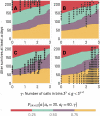The stability of transient relationships
- PMID: 37059731
- PMCID: PMC10104882
- DOI: 10.1038/s41598-023-32206-2
The stability of transient relationships
Abstract
In contrast to long-term relationships, far less is known about the temporal evolution of transient relationships, although these constitute a substantial fraction of people's communication networks. Previous literature suggests that ratings of relationship emotional intensity decay gradually until the relationship ends. Using mobile phone data from three countries (US, UK, and Italy), we demonstrate that the volume of communication between ego and its transient alters does not display such a systematic decay, instead showing a lack of any dominant trends. This means that the communication volume of egos to groups of similar transient alters is stable. We show that alters with longer lifetimes in ego's network receive more calls, with the lifetime of the relationship being predictable from call volume within the first few weeks of first contact. This is observed across all three countries, which include samples of egos at different life stages. The relation between early call volume and lifetime is consistent with the suggestion that individuals initially engage with a new alter so as to evaluate their potential as a tie in terms of homophily.
© 2023. The Author(s).
Conflict of interest statement
The authors declare no competing interests.
Figures





References
-
- Burt RS. Decay functions. Soc. Netw. 2000;22:1–28. doi: 10.1016/s0378-8733(99)00015-5. - DOI
-
- Mollenhorst G, Volker B, Flap H. Changes in personal relationships: How social contexts affect the emergence and discontinuation of relationships. Soc. Netw. 2014;37:65–80. doi: 10.1016/j.socnet.2013.12.003. - DOI
Publication types
MeSH terms
LinkOut - more resources
Full Text Sources
Miscellaneous

